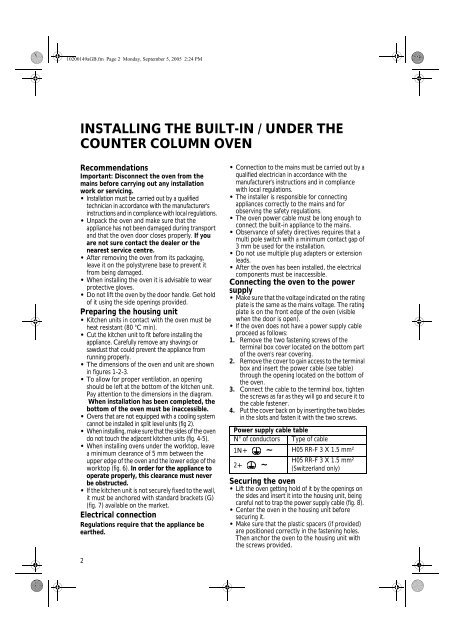KitchenAid 900 947 25 - 900 947 25 EN (857917816000) Installazione
KitchenAid 900 947 25 - 900 947 25 EN (857917816000) Installazione
KitchenAid 900 947 25 - 900 947 25 EN (857917816000) Installazione
You also want an ePaper? Increase the reach of your titles
YUMPU automatically turns print PDFs into web optimized ePapers that Google loves.
10200149aGB.fm Page 2 Monday, September 5, 2005 2:24 PM<br />
INSTALLING THE BUILT-IN / UNDER THE<br />
COUNTER COLUMN OV<strong>EN</strong><br />
Recommendations<br />
Important: Disconnect the oven from the<br />
mains before carrying out any installation<br />
work or servicing.<br />
• Installation must be carried out by a qualified<br />
technician in accordance with the manufacturer's<br />
instructions and in compliance with local regulations.<br />
• Unpack the oven and make sure that the<br />
appliance has not been damaged during transport<br />
and that the oven door closes properly. If you<br />
are not sure contact the dealer or the<br />
nearest service centre.<br />
• After removing the oven from its packaging,<br />
leave it on the polystyrene base to prevent it<br />
from being damaged.<br />
• When installing the oven it is advisable to wear<br />
protective gloves.<br />
• Do not lift the oven by the door handle. Get hold<br />
of it using the side openings provided.<br />
Preparing the housing unit<br />
• Kitchen units in contact with the oven must be<br />
heat resistant (80 °C min).<br />
• Cut the kitchen unit to fit before installing the<br />
appliance. Carefully remove any shavings or<br />
sawdust that could prevent the appliance from<br />
running properly.<br />
• The dimensions of the oven and unit are shown<br />
in figures 1-2-3.<br />
• To allow for proper ventilation, an opening<br />
should be left at the bottom of the kitchen unit.<br />
Pay attention to the dimensions in the diagram.<br />
When installation has been completed, the<br />
bottom of the oven must be inaccessible.<br />
• Ovens that are not equipped with a cooling system<br />
cannot be installed in split level units (fig 2).<br />
• When installing, make sure that the sides of the oven<br />
do not touch the adjacent kitchen units (fig. 4-5).<br />
• When installing ovens under the worktop, leave<br />
a minimum clearance of 5 mm between the<br />
upper edge of the oven and the lower edge of the<br />
worktop (fig. 6). In order for the appliance to<br />
operate properly, this clearance must never<br />
be obstructed.<br />
• If the kitchen unit is not securely fixed to the wall,<br />
it must be anchored with standard brackets (G)<br />
(fig. 7) available on the market.<br />
Electrical connection<br />
Regulations require that the appliance be<br />
earthed.<br />
• Connection to the mains must be carried out by a<br />
qualified electrician in accordance with the<br />
manufacturer's instructions and in compliance<br />
with local regulations.<br />
• The installer is responsible for connecting<br />
appliances correctly to the mains and for<br />
observing the safety regulations.<br />
• The oven power cable must be long enough to<br />
connect the built-in appliance to the mains.<br />
• Observance of safety directives requires that a<br />
multi pole switch with a minimum contact gap of<br />
3 mm be used for the installation.<br />
• Do not use multiple plug adapters or extension<br />
leads.<br />
• After the oven has been installed, the electrical<br />
components must be inaccessible.<br />
Connecting the oven to the power<br />
supply<br />
• Make sure that the voltage indicated on the rating<br />
plate is the same as the mains voltage. The rating<br />
plate is on the front edge of the oven (visible<br />
when the door is open).<br />
• If the oven does not have a power supply cable<br />
proceed as follows:<br />
1. Remove the two fastening screws of the<br />
terminal box cover located on the bottom part<br />
of the oven's rear covering.<br />
2. Remove the cover to gain access to the terminal<br />
box and insert the power cable (see table)<br />
through the opening located on the bottom of<br />
the oven.<br />
3. Connect the cable to the terminal box, tighten<br />
the screws as far as they will go and secure it to<br />
the cable fastener.<br />
4. Put the cover back on by inserting the two blades<br />
in the slots and fasten it with the two screws.<br />
Power supply cable table<br />
N° of conductors Type of cable<br />
1N+ ~ H05 RR-F 3 X 1.5 mm²<br />
H05 RR-F 3 X 1.5 mm²<br />
2+ ~<br />
(Switzerland only)<br />
Securing the oven<br />
• Lift the oven getting hold of it by the openings on<br />
the sides and insert it into the housing unit, being<br />
careful not to trap the power supply cable (fig. 8).<br />
• Center the oven in the housing unit before<br />
securing it.<br />
• Make sure that the plastic spacers (if provided)<br />
are positioned correctly in the fastening holes.<br />
Then anchor the oven to the housing unit with<br />
the screws provided.<br />
2
Fig. 2<br />
Fig. 1<br />
Fig. 3
Fig. 4 Fig. 5<br />
Fig. 6<br />
Fig. 7<br />
Fig. 8
















